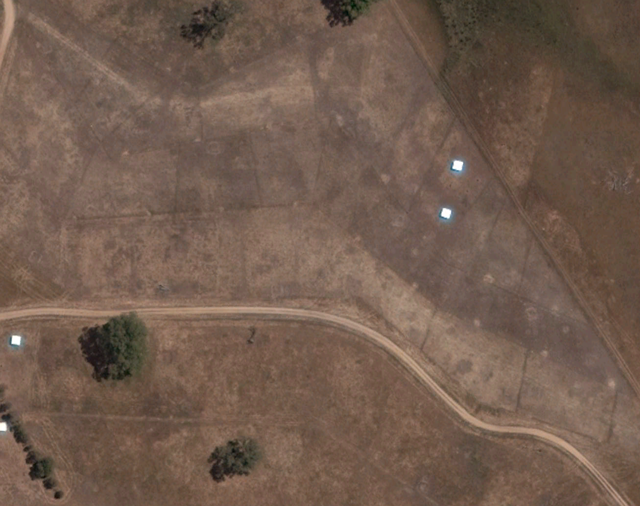
Credit: Jason Hagan, McIvor Farm (2014)
Extensivising Intensive – Strategies to Mitigate Risk for Intensive Animal Husbandry Systems
Recent rulings by the Victorian Civil and Administrative Tribunal (VCAT) have classified that some producers in Victoria are managing ‘intensive animal husbandry’ systems. Despite the immediate uproar, particularly focussed on ‘right to farm’ issues, including a high-profile and widely supported ‘Change.org’ petition, we see this ruling as bringing to a head risk management and mitigation discussions that Regrarians’ has been having for some years now. Over the last week or so these discussions have become more pronounced and pointed.
Its very clear to us that a number of producers, particularly those predominantly managing omnivores, are at risk of being classified as operating ‘intensive animal husbandry’ systems under the Victorian Planning Scheme (VPS) definitions. We have witnessed and observed any number of operations that, if we were to be investigate the ecological impacts of their management systems, would not rate as being sustainable let alone regenerative, ecological or holistic. This is in spite of many of these operations using these terms, and others, to describe their production systems. We see this as not being in their best interest, nor in the best interest of the ‘integrity food system’ (pers. comm. Salatin, 2009) that many of these producers would describe themselves as being part of.
To mitigate risk and potentially increase production and profitability we at Regrarians would recommend producers look at investigating the following:
1. Mapping & Monitoring — many producers are not mapping or monitoring their ecosystems or their livestock management systems as effectively as they could or at all. Best practice operations use mapping, monitoring and data capture as a means by which to improve their management outcomes. The data captured can not only prove just how close you are to being ‘intensive’ by the definition, but also provide you with the information you need to improve your operation.
Quite simply if you are not monitoring then how can you prove that you are not intensive? The authorities are going to make assumptions that could dramatically effect your business, why should you?
What kind of monitoring?
• Use smart phone apps such as ‘Measure Map‘ (Global DPI) to register the area you are providing to your livestock, the amount of time they spend in there and record the amount supplementary feed they are being provided — you can also record livestock health, condition and take before/after photos of each area. This information can be stored in software such as Google Earth and referred to for various planning purposes
• Use the Bullseye! process (Gadzia & Graham, 2009) and worksheets to monitor the ecosystem performance of different areas before, during and after each rotation.
• Use your monitoring outcomes to feed into a Holistic Planned Grazing regime (Savory, 1988) to not just optimise your operations, but also to plan future rotations regardless of the livestock and associated production system.
• Consider doing baseline sampling, in soil and water, of Phosphorus, Nitrogen, Carbon and Dissolved Oxygen — programming future sampling into your plans so that you can create a record of your levels of sequestration of these key elements and pollution triggers.
2. Grow your Own — provides the potential to tip the balance of feed back towards the definition of ‘extensive animal husbandry’, which is where over 50% of the ‘main food source’ comes from from the farm itself.
• Investigate ‘pasture’/‘no-kill’ cropping systems (Seis and Maynard et. al.) have proved a boon for producers wanting to establish single and mixed species annual cereal and grain legume crops directly into pastoral systems. These crops can either be harvested for storage and rationed feeding and/or left as standing forage which can be directly harvested by livestock.
• Look at integrated forage systems such as intensive sprouted fodder trays, black soldier fly larvae, fungi and aquatic plant production (e.g. Lemna sp. & Azolla sp.) to provide high quality, concentrated forages for livestock
• Manage your rotations such that you optimise the pastoral yields available. Keeping livestock in areas for too long, particularly pigs, increases the time that it takes before you can return and the yields that you would otherwise obtain.
• Consider irrigating areas to increase the yields available from pastoral and crop systems. Even a small area can have radically increased yields with timely irrigation.
3. Look at your Business Model — all enterprises have the capacity to increase their efficiency and this is sometimes one of the easiest ways to increase production and profitability.
• Investigate the prospect of value-adding or directly marketing your produce. The increased profitability of doing so may equate to you being able to run fewer livestock on your land and therefore get under the 50% threshold.
• Complete a Holistic Management Financial Plan (Savory, 1998) to get a thorough grasp on what it takes to meet your financial, personal and landscape expectations.
• Consider operating part of your system on another property as a leasehold or so-called ‘complementary enterprise’ (ibid. Salatin) — this may prove to be the circuit breaker to you getting under the extensive husbandry threshold.
4. Understand the Rules! — the 10 layer Regrarians Platform (Doherty, 2012) recommends that people assess their planning rules and definitions as part of the ‘1. Climate’ layer investigation (Doherty & Jeeves, 2015). Most planning rules are relatively simple to understand, as are the land use definitions. As with many things, it is the interpretation of these rules, definitions and respective rulings which are sometimes difficult for producers to understand and plan around.
• We recommend having conversations with municipal planning officers, consultants and other producers and producer groups to navigate the pathways to find greater clarity and so protect agricultural and food industry business interests and investments, including your own!
• Don’t be afraid to use the many forums that now exist to voice your concerns and questions. You are not the only one trying to make your way in all of this.
• Don’t try and bullshit your way through all or any of this — it doesn’t help you or the rest of the integrity food movement we are all trying to make the new normal.
• Keep an eye out on the development of the ‘Australia Farmer to Consumer Legal Defence Fund’ (AF2CLDF) by joining the Australian Food Sovereignty Alliance (AFSA – http://www.australianfoodsovereigntyalliance.org/)
5. Practice what You Preach — many operations have developed a marketing narrative that suggests they use terms such as ‘sustainable’, ‘regenerative’ and ‘beyond organic (etc.)’ that their production systems are just that. As mentioned earlier, this is a risky business if you are not — even certification by organic or biodynamic certifiers doesn’t guarantee that production systems are sustainable, regenerative or otherwise.
• Consider carefully the language that you use to market your products and the production system that is behind it.
• Use the outcomes of monitoring data to build the scientific case for the use of various terms
• Be very aware that neither industrial agriculture nor the industrial food system is fond of the way you choose to manage your production, processing, marketing or distribution systems. The influence that they wield with respect to lobbying and political has clearly shaped the regulatory landscape we all have to work within.
• Be up front with your consumers/eaters and supporters about your production system and the journey you’re on to getting your place and the food it produce as great as it can be. These people will be your greatest ally if/when the regulator knocks on your door. The more of them we turn onto the integrity food system the more we will see changes in the food system!
“…show me a movement and I’ll move!….”, USA President Barack H. Obama
6. Share your Processes and Results — a clear pathway to increasing the likelihood that the integrity food system will become the new normal and orthodoxy is by producers adopting a collegiate approach with sharing their best practice outcomes.
• Ask yourself who are you really in competition with? Is it the industrial food system or is it that other integrity food producer?
• What is there to be gained by you taking a leadership role in sharing your successes with others so that the whole industry becomes stronger?
• What is there to be gained by you and others when you do have that data out there that demonstrates that your production system beats the threshold of intensive production?
Credit: GoogleEarth 2014
Victorian Planning Scheme – Definitions (relevant) – Clause 74 (11/06/2015 VC125)
Agriculture
Land used to: a) propagate, cultivate or harvest plants, including cereals, flowers, fruit, seeds, trees, turf, and vegetables; b) keep, breed, board, or train animals, including livestock, and birds; or c) propagate, cultivate, rear, or harvest living resources of the sea or inland waters
Animal husbandry
Land used to keep, breed, board, or train animals, including birds.
Broiler farm
Land used to keep broiler chickens which are housed permanently in sheds and reared for meat production.
Cattle feedlot
Land used to keep and fatten cattle which are restrained by pens or enclosures and intensively fed.
Extensive animal husbandry
Land used to keep or breed farm animals, including birds, at an intensity where the animals’ main food source is obtained by grazing, browsing, or foraging on plants grown on the land. It includes: a) emergency and supplementary feeding; and b) the incidental penning and housing of animals, including birds, for brooding, weaning, dipping, or other husbandry purposes.
Intensive animal husbandry
Land used to keep or breed farm animals, including birds, by importing most food from outside the enclosures. It does not include: a) an abattoir or sale yard; b) emergency and supplementary feeding if incidental to the use of land for extensive animal husbandry; or c) the penning and housing of animals, including birds, for brooding, weaning, dipping or other husbandry purposes if incidental to the use of land for extensive animal husbandry.
Further Information & Resources:
• Victorian Planning Scheme – Definitions – Clause 74 (11/06/2015 VC125) — http://planningschemes.dpcd.vic.gov.au/schemes/vpps/74.pdf
• Australian Food Sovereignty Alliance — http://www.australianfoodsovereigntyalliance.org/
• Regrarians Facebook Group – https://www.facebook.com/groups/Regrarians
• Regrarians Handbook – http://www.regrarians.org/product-category/ebook/
• Bullseye! – Targeting Your Rangeland Health Objectives – http://quiviracoalition.org/images/pdfs/5252-2013%2520Bullseye.pdf
• Savory Institute eBooks, Planning and Monitoring – http://savory-institute.myshopify.com/collections/ebooks-and-materials
• Pasture & No-Kill Cropping – http://www.nokillcropping.com/
• Measure Map – http://www.measuremapapp.com/press2/?page_id=669


Thanks Darren. This is gr8!
Pingback: Issue 2: Meat | The Farm Ecologist